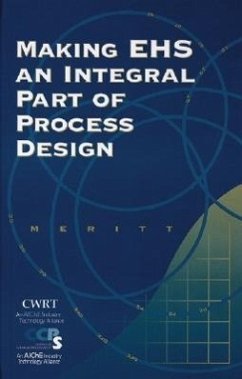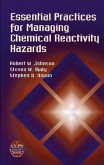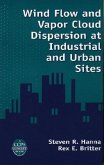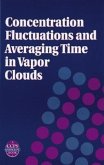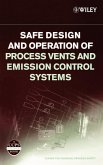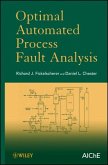Arthur D Little Inc
Making EHS an Integral Part of Process Design
Arthur D Little Inc
Making EHS an Integral Part of Process Design
- Gebundenes Buch
- Merkliste
- Auf die Merkliste
- Bewerten Bewerten
- Teilen
- Produkt teilen
- Produkterinnerung
- Produkterinnerung
This book presents an approach--termed MERITT (Maximizing EHS Returns by Integrating Tools and Talents)--for enhancing process development through better integration of environmental, health, and safety evaluations. It draws upon critical components of inherent safety, pollution prevention, green chemistry, and related paradigms through selective adoption and adaptation of their existing tools, skills, and knowledge resources. MERITT offers ways of enhancing existing best practices of organizations that are recognized leaders in developing and conducting coordinated EHS evaluations through…mehr
Andere Kunden interessierten sich auch für
![Essential Practices for Managing Chemical Reactivity Hazards Essential Practices for Managing Chemical Reactivity Hazards]() Robert W JohnsonEssential Practices for Managing Chemical Reactivity Hazards190,99 €
Robert W JohnsonEssential Practices for Managing Chemical Reactivity Hazards190,99 €![Wind Flow and Vapor Cloud Dispersion at Industrial and Urban Sites Wind Flow and Vapor Cloud Dispersion at Industrial and Urban Sites]() Steven R HannaWind Flow and Vapor Cloud Dispersion at Industrial and Urban Sites258,99 €
Steven R HannaWind Flow and Vapor Cloud Dispersion at Industrial and Urban Sites258,99 €![Deflagration and Detonation Flame Arresters Deflagration and Detonation Flame Arresters]() Stanley S GrosselDeflagration and Detonation Flame Arresters185,99 €
Stanley S GrosselDeflagration and Detonation Flame Arresters185,99 €![Concentration Fluctuations and Averaging Time in Vapor Clouds Concentration Fluctuations and Averaging Time in Vapor Clouds]() David J WilsonConcentration Fluctuations and Averaging Time in Vapor Clouds190,99 €
David J WilsonConcentration Fluctuations and Averaging Time in Vapor Clouds190,99 €![Safe Design and Operation of Process Vents and Emission Control Systems Safe Design and Operation of Process Vents and Emission Control Systems]() Center for Chemical Process Safety (CCPS)Safe Design and Operation of Process Vents and Emission Control Systems188,99 €
Center for Chemical Process Safety (CCPS)Safe Design and Operation of Process Vents and Emission Control Systems188,99 €![Optimal Automated Process Fault Analysis Optimal Automated Process Fault Analysis]() Richard J. FickelschererOptimal Automated Process Fault Analysis137,99 €
Richard J. FickelschererOptimal Automated Process Fault Analysis137,99 €![Guidelines for Implementing Process Safety Management Guidelines for Implementing Process Safety Management]() Center for Chemical Process Safety (CCPS)Guidelines for Implementing Process Safety Management135,99 €
Center for Chemical Process Safety (CCPS)Guidelines for Implementing Process Safety Management135,99 €-
-
-
This book presents an approach--termed MERITT (Maximizing EHS Returns by Integrating Tools and Talents)--for enhancing process development through better integration of environmental, health, and safety evaluations. It draws upon critical components of inherent safety, pollution prevention, green chemistry, and related paradigms through selective adoption and adaptation of their existing tools, skills, and knowledge resources. MERITT offers ways of enhancing existing best practices of organizations that are recognized leaders in developing and conducting coordinated EHS evaluations through increased awareness and recognition throughout all levels of the organization (engineers, chemists, project managers, and business leaders). Special Details: Hardcover. Co-publishing venture between CWRT and CCPS.
Hinweis: Dieser Artikel kann nur an eine deutsche Lieferadresse ausgeliefert werden.
Hinweis: Dieser Artikel kann nur an eine deutsche Lieferadresse ausgeliefert werden.
Produktdetails
- Produktdetails
- Verlag: Wiley
- Seitenzahl: 164
- Erscheinungstermin: 15. Juni 2001
- Englisch
- Abmessung: 231mm x 160mm x 18mm
- Gewicht: 476g
- ISBN-13: 9780816908486
- ISBN-10: 0816908486
- Artikelnr.: 29928375
- Herstellerkennzeichnung
- Produktsicherheitsverantwortliche/r
- Europaallee 1
- 36244 Bad Hersfeld
- gpsr@libri.de
- Verlag: Wiley
- Seitenzahl: 164
- Erscheinungstermin: 15. Juni 2001
- Englisch
- Abmessung: 231mm x 160mm x 18mm
- Gewicht: 476g
- ISBN-13: 9780816908486
- ISBN-10: 0816908486
- Artikelnr.: 29928375
- Herstellerkennzeichnung
- Produktsicherheitsverantwortliche/r
- Europaallee 1
- 36244 Bad Hersfeld
- gpsr@libri.de
Arthur D. Little is an international management consulting firm originally headquartered in Boston, Massachusetts, United States, and formally incorporated by that name in 1909 by Arthur Dehon Little, an MIT chemist who had discovered acetate. Arthur D. Little pioneered the concept of contracted professional services.
Preface.
Acknowledgments.
Acronyms.
1. Introduction.
1.1 The Need for MERITT.
1.2 What Does MERITT Offer?
1.3 Whom Is MERITT for?
1.4 About the Book.
1.4.1 Scope.
1.4.2 Organization.
1.5 The Path Forward.
2. Value and Benefits.
2.1 The Value of MERITT.
2.1.1 Making More Efficient Use of Resources.
2.1.2 Examples of Success and Syneregy.
2.2 The Perils of Not Following the MERITT Approach.
2.3 The Business Case for MERITT.
2.3.1 Sustainability.
2.3.2 Meeting New Regulatory Demands.
2.4 The Need for Cost and Benefit Metrics to Demonstrate Value.
2.4.1 WBCSD.
2.4.2 ORC.
2.4.3 Recommendations Regarding Metrics.
3. Life-Cycle Stages.
3.1 Introduction.
3.2 Phases of Development.
3.3 Staging and Control.
3.3.1 Generic Stages.
3.3.2 Resource Allocation and Control.
3.3.3 Interpretation of Stages.
3.4 EHS Constraints and Opportunities.
3.4.1 Stage Constraints.
3.4.2 EHS Opportunities.
3.5 EHS Information Needs.
3.5.1 Requirements.
3.5.2 Anticipating Information Needs.
3.6 Fast-Track Development.
3.7 Plant Upgrades and Modifications.
3.7.1 Stage Iteration.
3.7.2 Creating MERITT Opportunity.
3.8 References.
4. The MERITT Opportunity.
4.1 The Foundation of MERITT.
4.2 MERITT Approach Overview.
4.2.1 The Basic MERITT Framework.
4.2.2 The Five "C" Fundamental Principles.
4.2.3 Resource Components.
4.2.4 Implementation Elements.
4.2.5 Overall Format-Fitting It All Together.
4.3 Application of MERITT to Stage-Gate Development Processes.
4.3.1 Early Stages-Concept Initiation (Stage 1) and Process Chemistry
(Stage 2).
4.3.2 Process Definition (Stage 3).
4.3.3 Basic Process Engineering (Stage 4).
4.4 Fast Tracking with MERITT.
4.4.1 Fast Tracking Implementation Elements.
4.4.2 Fast Tracking Resource Components.
5. MERITT Tools.
5.1 Introduction.
5.1.1 Need for tools.
5.1.2 Purpose of Tools.
5.1.3 Types of Tools.
5.1.4 Relationship of Tools and Stages.
5.2 Available Tools.
5.2.1 Nonintegrated Tools.
5.2.2 Integrated Tools.
5.3 Need for Integrated Tools.
5.3.1 Role of MERITT Tools.
5.3.2 Illustrative MERITT Tools.
5.4 Development Needs.
5.5 Reference.
6. Application of MERITT.
6.1 Introduction.
6.2 Situation.
6.2.1 Waste.
6.2.2 Safety Hazards.
6.2.3 Green Chemistry Issues.
6.3 Nonintegrated EHS Approach.
6.3.1 Set Goals.
6.3.2 Define the Problem.
6.3.3 Identify Options.
6.3.4 Screening of Options.
6.3.5 Idea Evaluation.
6.3.6 Results.
6.4 MERITT Approach.
6.4.1 Establishing the Basis.
6.4.2 Identifying Issues.
6.4.3 Developing Options.
6.4.4 Assessing Options.
6.4.5 Improved Process.
6.4.6 MERITT Achievements.
6.5 Product Development Example.
6.5.1 Situation.
6.5.2 Use of MERITT.
6.6 References.
7. Implementation Guidance.
7.1 Incorporating MERITT into an Existing Process Development Process.
7.2 Integration with product Development Process.
7.3 Overcoming Behavioral and Cultural Barriers.
7.4 Metrics.
7.5 Addressing Industry-Specific Issues.
7.6 Applying to Small Companies.
7.7 Evaluating Licenses.
Appendix A. Additional Tools with Applicability to MERITT.
Appendix B. Overview of the INSET Tools and Their Aims.
Appendix C. The Business Case for Managing Process Safety.
Index.
Acknowledgments.
Acronyms.
1. Introduction.
1.1 The Need for MERITT.
1.2 What Does MERITT Offer?
1.3 Whom Is MERITT for?
1.4 About the Book.
1.4.1 Scope.
1.4.2 Organization.
1.5 The Path Forward.
2. Value and Benefits.
2.1 The Value of MERITT.
2.1.1 Making More Efficient Use of Resources.
2.1.2 Examples of Success and Syneregy.
2.2 The Perils of Not Following the MERITT Approach.
2.3 The Business Case for MERITT.
2.3.1 Sustainability.
2.3.2 Meeting New Regulatory Demands.
2.4 The Need for Cost and Benefit Metrics to Demonstrate Value.
2.4.1 WBCSD.
2.4.2 ORC.
2.4.3 Recommendations Regarding Metrics.
3. Life-Cycle Stages.
3.1 Introduction.
3.2 Phases of Development.
3.3 Staging and Control.
3.3.1 Generic Stages.
3.3.2 Resource Allocation and Control.
3.3.3 Interpretation of Stages.
3.4 EHS Constraints and Opportunities.
3.4.1 Stage Constraints.
3.4.2 EHS Opportunities.
3.5 EHS Information Needs.
3.5.1 Requirements.
3.5.2 Anticipating Information Needs.
3.6 Fast-Track Development.
3.7 Plant Upgrades and Modifications.
3.7.1 Stage Iteration.
3.7.2 Creating MERITT Opportunity.
3.8 References.
4. The MERITT Opportunity.
4.1 The Foundation of MERITT.
4.2 MERITT Approach Overview.
4.2.1 The Basic MERITT Framework.
4.2.2 The Five "C" Fundamental Principles.
4.2.3 Resource Components.
4.2.4 Implementation Elements.
4.2.5 Overall Format-Fitting It All Together.
4.3 Application of MERITT to Stage-Gate Development Processes.
4.3.1 Early Stages-Concept Initiation (Stage 1) and Process Chemistry
(Stage 2).
4.3.2 Process Definition (Stage 3).
4.3.3 Basic Process Engineering (Stage 4).
4.4 Fast Tracking with MERITT.
4.4.1 Fast Tracking Implementation Elements.
4.4.2 Fast Tracking Resource Components.
5. MERITT Tools.
5.1 Introduction.
5.1.1 Need for tools.
5.1.2 Purpose of Tools.
5.1.3 Types of Tools.
5.1.4 Relationship of Tools and Stages.
5.2 Available Tools.
5.2.1 Nonintegrated Tools.
5.2.2 Integrated Tools.
5.3 Need for Integrated Tools.
5.3.1 Role of MERITT Tools.
5.3.2 Illustrative MERITT Tools.
5.4 Development Needs.
5.5 Reference.
6. Application of MERITT.
6.1 Introduction.
6.2 Situation.
6.2.1 Waste.
6.2.2 Safety Hazards.
6.2.3 Green Chemistry Issues.
6.3 Nonintegrated EHS Approach.
6.3.1 Set Goals.
6.3.2 Define the Problem.
6.3.3 Identify Options.
6.3.4 Screening of Options.
6.3.5 Idea Evaluation.
6.3.6 Results.
6.4 MERITT Approach.
6.4.1 Establishing the Basis.
6.4.2 Identifying Issues.
6.4.3 Developing Options.
6.4.4 Assessing Options.
6.4.5 Improved Process.
6.4.6 MERITT Achievements.
6.5 Product Development Example.
6.5.1 Situation.
6.5.2 Use of MERITT.
6.6 References.
7. Implementation Guidance.
7.1 Incorporating MERITT into an Existing Process Development Process.
7.2 Integration with product Development Process.
7.3 Overcoming Behavioral and Cultural Barriers.
7.4 Metrics.
7.5 Addressing Industry-Specific Issues.
7.6 Applying to Small Companies.
7.7 Evaluating Licenses.
Appendix A. Additional Tools with Applicability to MERITT.
Appendix B. Overview of the INSET Tools and Their Aims.
Appendix C. The Business Case for Managing Process Safety.
Index.
Preface.
Acknowledgments.
Acronyms.
1. Introduction.
1.1 The Need for MERITT.
1.2 What Does MERITT Offer?
1.3 Whom Is MERITT for?
1.4 About the Book.
1.4.1 Scope.
1.4.2 Organization.
1.5 The Path Forward.
2. Value and Benefits.
2.1 The Value of MERITT.
2.1.1 Making More Efficient Use of Resources.
2.1.2 Examples of Success and Syneregy.
2.2 The Perils of Not Following the MERITT Approach.
2.3 The Business Case for MERITT.
2.3.1 Sustainability.
2.3.2 Meeting New Regulatory Demands.
2.4 The Need for Cost and Benefit Metrics to Demonstrate Value.
2.4.1 WBCSD.
2.4.2 ORC.
2.4.3 Recommendations Regarding Metrics.
3. Life-Cycle Stages.
3.1 Introduction.
3.2 Phases of Development.
3.3 Staging and Control.
3.3.1 Generic Stages.
3.3.2 Resource Allocation and Control.
3.3.3 Interpretation of Stages.
3.4 EHS Constraints and Opportunities.
3.4.1 Stage Constraints.
3.4.2 EHS Opportunities.
3.5 EHS Information Needs.
3.5.1 Requirements.
3.5.2 Anticipating Information Needs.
3.6 Fast-Track Development.
3.7 Plant Upgrades and Modifications.
3.7.1 Stage Iteration.
3.7.2 Creating MERITT Opportunity.
3.8 References.
4. The MERITT Opportunity.
4.1 The Foundation of MERITT.
4.2 MERITT Approach Overview.
4.2.1 The Basic MERITT Framework.
4.2.2 The Five "C" Fundamental Principles.
4.2.3 Resource Components.
4.2.4 Implementation Elements.
4.2.5 Overall Format-Fitting It All Together.
4.3 Application of MERITT to Stage-Gate Development Processes.
4.3.1 Early Stages-Concept Initiation (Stage 1) and Process Chemistry
(Stage 2).
4.3.2 Process Definition (Stage 3).
4.3.3 Basic Process Engineering (Stage 4).
4.4 Fast Tracking with MERITT.
4.4.1 Fast Tracking Implementation Elements.
4.4.2 Fast Tracking Resource Components.
5. MERITT Tools.
5.1 Introduction.
5.1.1 Need for tools.
5.1.2 Purpose of Tools.
5.1.3 Types of Tools.
5.1.4 Relationship of Tools and Stages.
5.2 Available Tools.
5.2.1 Nonintegrated Tools.
5.2.2 Integrated Tools.
5.3 Need for Integrated Tools.
5.3.1 Role of MERITT Tools.
5.3.2 Illustrative MERITT Tools.
5.4 Development Needs.
5.5 Reference.
6. Application of MERITT.
6.1 Introduction.
6.2 Situation.
6.2.1 Waste.
6.2.2 Safety Hazards.
6.2.3 Green Chemistry Issues.
6.3 Nonintegrated EHS Approach.
6.3.1 Set Goals.
6.3.2 Define the Problem.
6.3.3 Identify Options.
6.3.4 Screening of Options.
6.3.5 Idea Evaluation.
6.3.6 Results.
6.4 MERITT Approach.
6.4.1 Establishing the Basis.
6.4.2 Identifying Issues.
6.4.3 Developing Options.
6.4.4 Assessing Options.
6.4.5 Improved Process.
6.4.6 MERITT Achievements.
6.5 Product Development Example.
6.5.1 Situation.
6.5.2 Use of MERITT.
6.6 References.
7. Implementation Guidance.
7.1 Incorporating MERITT into an Existing Process Development Process.
7.2 Integration with product Development Process.
7.3 Overcoming Behavioral and Cultural Barriers.
7.4 Metrics.
7.5 Addressing Industry-Specific Issues.
7.6 Applying to Small Companies.
7.7 Evaluating Licenses.
Appendix A. Additional Tools with Applicability to MERITT.
Appendix B. Overview of the INSET Tools and Their Aims.
Appendix C. The Business Case for Managing Process Safety.
Index.
Acknowledgments.
Acronyms.
1. Introduction.
1.1 The Need for MERITT.
1.2 What Does MERITT Offer?
1.3 Whom Is MERITT for?
1.4 About the Book.
1.4.1 Scope.
1.4.2 Organization.
1.5 The Path Forward.
2. Value and Benefits.
2.1 The Value of MERITT.
2.1.1 Making More Efficient Use of Resources.
2.1.2 Examples of Success and Syneregy.
2.2 The Perils of Not Following the MERITT Approach.
2.3 The Business Case for MERITT.
2.3.1 Sustainability.
2.3.2 Meeting New Regulatory Demands.
2.4 The Need for Cost and Benefit Metrics to Demonstrate Value.
2.4.1 WBCSD.
2.4.2 ORC.
2.4.3 Recommendations Regarding Metrics.
3. Life-Cycle Stages.
3.1 Introduction.
3.2 Phases of Development.
3.3 Staging and Control.
3.3.1 Generic Stages.
3.3.2 Resource Allocation and Control.
3.3.3 Interpretation of Stages.
3.4 EHS Constraints and Opportunities.
3.4.1 Stage Constraints.
3.4.2 EHS Opportunities.
3.5 EHS Information Needs.
3.5.1 Requirements.
3.5.2 Anticipating Information Needs.
3.6 Fast-Track Development.
3.7 Plant Upgrades and Modifications.
3.7.1 Stage Iteration.
3.7.2 Creating MERITT Opportunity.
3.8 References.
4. The MERITT Opportunity.
4.1 The Foundation of MERITT.
4.2 MERITT Approach Overview.
4.2.1 The Basic MERITT Framework.
4.2.2 The Five "C" Fundamental Principles.
4.2.3 Resource Components.
4.2.4 Implementation Elements.
4.2.5 Overall Format-Fitting It All Together.
4.3 Application of MERITT to Stage-Gate Development Processes.
4.3.1 Early Stages-Concept Initiation (Stage 1) and Process Chemistry
(Stage 2).
4.3.2 Process Definition (Stage 3).
4.3.3 Basic Process Engineering (Stage 4).
4.4 Fast Tracking with MERITT.
4.4.1 Fast Tracking Implementation Elements.
4.4.2 Fast Tracking Resource Components.
5. MERITT Tools.
5.1 Introduction.
5.1.1 Need for tools.
5.1.2 Purpose of Tools.
5.1.3 Types of Tools.
5.1.4 Relationship of Tools and Stages.
5.2 Available Tools.
5.2.1 Nonintegrated Tools.
5.2.2 Integrated Tools.
5.3 Need for Integrated Tools.
5.3.1 Role of MERITT Tools.
5.3.2 Illustrative MERITT Tools.
5.4 Development Needs.
5.5 Reference.
6. Application of MERITT.
6.1 Introduction.
6.2 Situation.
6.2.1 Waste.
6.2.2 Safety Hazards.
6.2.3 Green Chemistry Issues.
6.3 Nonintegrated EHS Approach.
6.3.1 Set Goals.
6.3.2 Define the Problem.
6.3.3 Identify Options.
6.3.4 Screening of Options.
6.3.5 Idea Evaluation.
6.3.6 Results.
6.4 MERITT Approach.
6.4.1 Establishing the Basis.
6.4.2 Identifying Issues.
6.4.3 Developing Options.
6.4.4 Assessing Options.
6.4.5 Improved Process.
6.4.6 MERITT Achievements.
6.5 Product Development Example.
6.5.1 Situation.
6.5.2 Use of MERITT.
6.6 References.
7. Implementation Guidance.
7.1 Incorporating MERITT into an Existing Process Development Process.
7.2 Integration with product Development Process.
7.3 Overcoming Behavioral and Cultural Barriers.
7.4 Metrics.
7.5 Addressing Industry-Specific Issues.
7.6 Applying to Small Companies.
7.7 Evaluating Licenses.
Appendix A. Additional Tools with Applicability to MERITT.
Appendix B. Overview of the INSET Tools and Their Aims.
Appendix C. The Business Case for Managing Process Safety.
Index.

